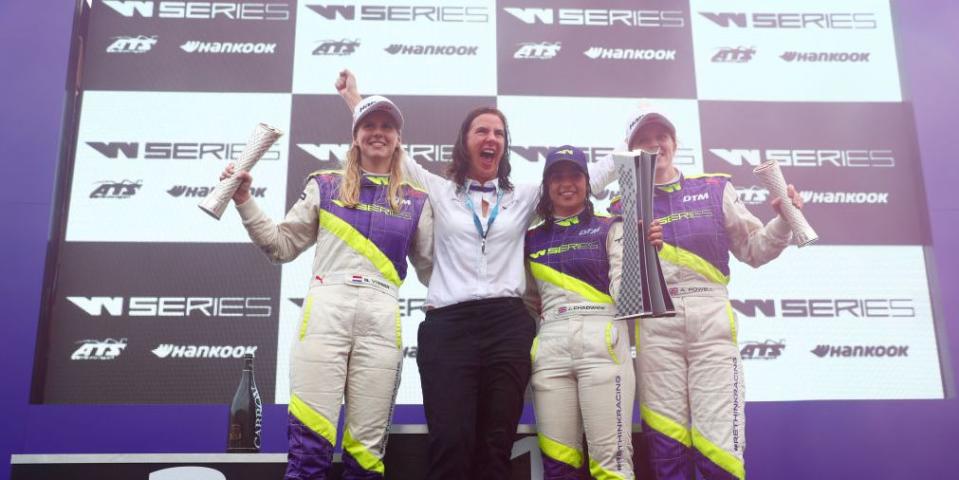W Series Joining F1 Could Be a Watershed Moment for Women in Racing

Recent news of a season-long partnership between Formula 1 and the W Series has the potential to radically alter the sport’s future.
Among the biggest developments of the year, F1 selecting the all-women driver development championship as its preferred support series is poised bring a vast new audience to the women who will form the 2021 grid. The W Series is expected to be embedded for eight F1 weekends, at to-be-announced venues.
The alliance brings the weight of F1’s legitimacy, influence, and fanbase to the growing new series. Freed from the notion that it lives on the fringes, the W Series has now received racing’s most coveted endorsement. With F1 in their corner, we can envision a future where decades of apathy and tokenism directed at female racers will meet a welcome end. Good lord, it’s long overdue.
Above, left to right: Beitske Visser, W Series CEO Catherine Bond Muir, series champion Jamie Chadwick, and Alice Powell celebrating on the podium at Brands Hatch in August 2019.
As part of the next F1 calendar, the W Series has a transformational opportunity to showcase the skills within its driver ranks. Set for a grand new stage, F1’s welcoming of the series is the dream outcome long sought by CEO Catherine Bond Muir and her colleagues.
"I think we have had a lot of happy dances today," Muir told Road & Track after the news was revealed. "I think all of us are really just overwhelmed that we have traveled so far in such a relatively short amount of time. We started off with a really small team of people; we only had 11 full-time employees in the first year. And what they managed to do was put on a really professional motor racing series that reached all corners of the world. We only had six races, [but] in the U.K., for example, we were the second-most-watched female sport and we were the second-most-watched motorsport. So I think what we did struck a chord, and we were so jubilant after the first year."
Launched in 2019, the open-wheel training series spent its first season attached to the DTM championship. Two exceptional talents garnered most of the accolades during the W Series’ debut, with England’s Jamie Chadwick earning the inaugural championship and her countrywoman Alice Powell placing second. But despite the interest the W Series earned, its placement on the undercard of the storied but comparatively small DTM meant that Chadwick, Powell and their competitors performed far from the strongest international spotlight.
Forced to cancel its sophomore season due to the global pandemic, whatever degree of momentum the W Series generated in 2019 was all but lost as the drivers set to contest its second championship sat idle in 2020.
"Sitting here where we are, we're just on the verge of showing ourselves in front of the world and we will have so much greater exposure," Muir said. "And we thank Formula 1 so much for wanting to be a partner of ours so we can work with them and make Formula 1 weekends more diverse.
"I think Formula 1 has done very well to date about expanding the numbers of women who work in all of the teams. Certainly Formula 1 itself [has] an awful lot of very senior women who work there. And I suspect they felt the one area that was missing was actually in women being out on track. And I think W Series helped solve that diversity issue for them."
The W Series was never going to fulfill its potential while connected to the wonderful but niche German sports car organization. Mass and volume have been the missing ingredients in normalizing women athletes in motorsports.
Chart the lineal influence of Janet Guthrie, the first woman to race at the Indianapolis 500. Those who followed her 1977 debut can thank the soft-spoken American as a pioneer, inspiring young girls and women to pursue careers in racing. Lyn St. James, Sarah Fisher, Danica Patrick, and Simona de Silvestro are among the small number of inspiring women drivers who’ve followed the path the Iowa native carved to Indianapolis. The same can be said of rallying legend Michele Mouton and her influence on a generation of women racers.
There are more, but not many. In most instances, fans can count by hand every female racer to have graced a popular championship, with fingers to spare. It’s a dishearteningly familiar tune heard in too many racing series.
A historical lack of representation and visibility is the core of the problem. Too few women have had quality opportunities to drive, own, manage, mechanic, or engineer.
"There's so many different forms of motorsports today that have enabled so many different types of people to get excited and participate and be successful in the sport," said the 73-year-old St. James, who qualified sixth in the field of 33 drivers at the 1994 Indy 500. "But then it boils down to, where's the cream of the crop? Where are the top levels? There's NASCAR, there's IndyCar, there's NHRA [...] if you aren’t in those categories, you don't exist in their eyes."
When the W Series comes to the international stage as the next F1 season gets underway, it will offer inspiration to audiences that have rarely seen themselves in the top echelons of racing. "A lot of those [watching] are young girls, or young Hispanic or young African-American people," St. James said. "And if you don't see it, you can't be it."
Norway’s Ayla Agren shows what an inspiring role model can mean to a young woman. Inspired by Danica Patrick’s stunning rookie performance at the 2005 Indy 500, Agren began karting in Europe, moving to the U.S. in her late teens to pursue open-wheel glory. Working with a tight budget, Agren was often relegated to smaller developmental series or partial-season campaigns.

 Yahoo Autos
Yahoo Autos 